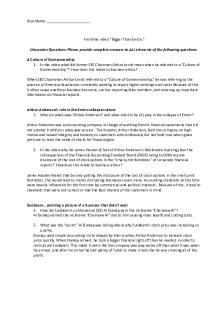Bigger THAN Enron - Discussion Questions - Worksheet PDF

| Title | Bigger THAN Enron - Discussion Questions - Worksheet |
|---|---|
| Course | General Business 101 |
| Institution | Boise State University |
| Pages | 2 |
| File Size | 59.8 KB |
| File Type | |
| Total Downloads | 65 |
| Total Views | 153 |
Summary
Professor Cheryl Larabee. You will have to watch this movie and answer questions. I received a 100% on this. ...
Description
Your Name: _____________________
Frontline video "Bigger Than Enron." Discussion Questions: Please provide complete answers to ALL elements of the following questions. A Culture of Gamesmanship 1. In the video what did former SEC Chairman Arthur Levitt mean when he referred to a “Culture of Gamesmanship”? How does this relate to business ethics? When SEC Chairnman Arthur Levitt referred to a “Culture of Gamesmanship,” he was referring to the practice of American businesses constantly wanting to report higher earnings each year. Because of this, it often cause unethical business decisions, such as reporting false numbers, and covering up important information on financial reports.
Arthur Anderson’s role in the Enron collapse culture 2. Who (or what) was “Arthur Andersen” and what role did he (it) play in the collapse of Enron? Arthur Anderson was an accounting company in charge of auditing Enron’s financial statements that did not provide truthful or adequate service. The founder, Arthur Anderson, built the company on high morals and valued integrity and honesty to customers which obviously did not hold true when given pressure to raise the value of stocks for financial gain. 3. In the video why did James Hooten (Chief of Arthur Andersen’s Worldwide Auditing) fear the consequences of the Financial Accounting Standard Board (FASB) ruling to ONLY require disclosure of the cost of stock options in the “small print footnotes” of corporate financial reports? How does this relate to business ethics? James Hooten feared that by only putting the disclosure of the cost of stock options in the small print footnotes, this would lead to clients distrusting businesses even more. Accounting standards at this time were heavily influenced for the first time by commercial and political interests. Because of this, it lead to standards that were not correct or had the best interest of the customers in mind.
Sunbeam… painting a picture of a business that didn’t exist 4. How did Sunbeam’s controversial CEO Al Dunlap earn the nickname “Chainsaw Al”? Al Dunlap earned the nickname “Chainsaw Al” due to him causing mass layoffs and cutting costs. 5. What was the “secret” Al Dunlap was hiding about why Sunbeam’s stock price was increasing so quickly. Dunlap used simple accounting tricks okayed by their auditor Arthur Anderson to increase stock price quickly. When Dunlap arrived, he took a bigger financial right off than he needed in order to restructure Sunbeam. This made it seem like the company was way worse off than what it was when he arrived, and after his arrival he had plenty of funds to make it look like he was creating all of this profit.
Your Name: _____________________
Enron’s power grows as Arthur Andersen leaders struggle to maintain their ethics. 6. What did Charles E. Bass do to try to maintain Arthur Andersen’s integrity in their relationship with Enron? What were the consequences of Mr. Bass’ efforts? Bass tried to maintain Arthur Andersen’s integrity by sending out emails and memos that challenged their accounting and pointed out errors in order to keep the rules in order. Because of this, Enron became angry and took Bass off of the account, even though Bass only did this to maintain the integrity of the company.
7. Ten months before Enron went “bust” ten Arthur Andersen partners debated whether or not to keep Enron as a client. What did they decide to do and why? Arthur Andersen partners ended keeping Enron as a client after their debate because they found that the account would end up being worth $100 million a year to Andersen creating a major profit....
Similar Free PDFs

Enron Discussion
- 2 Pages

Discussion Questions
- 4 Pages

Enron-Scandal - enron scandal
- 19 Pages

Discussion Questions
- 3 Pages

Discussion 2 - Worksheet
- 3 Pages

Discussion Worksheet 4-keys
- 2 Pages

Worksheet Questions
- 11 Pages

Enron-Scandal
- 2 Pages

Road to Bigger Glutes Home
- 30 Pages

is bigger better
- 9 Pages
Popular Institutions
- Tinajero National High School - Annex
- Politeknik Caltex Riau
- Yokohama City University
- SGT University
- University of Al-Qadisiyah
- Divine Word College of Vigan
- Techniek College Rotterdam
- Universidade de Santiago
- Universiti Teknologi MARA Cawangan Johor Kampus Pasir Gudang
- Poltekkes Kemenkes Yogyakarta
- Baguio City National High School
- Colegio san marcos
- preparatoria uno
- Centro de Bachillerato Tecnológico Industrial y de Servicios No. 107
- Dalian Maritime University
- Quang Trung Secondary School
- Colegio Tecnológico en Informática
- Corporación Regional de Educación Superior
- Grupo CEDVA
- Dar Al Uloom University
- Centro de Estudios Preuniversitarios de la Universidad Nacional de Ingeniería
- 上智大学
- Aakash International School, Nuna Majara
- San Felipe Neri Catholic School
- Kang Chiao International School - New Taipei City
- Misamis Occidental National High School
- Institución Educativa Escuela Normal Juan Ladrilleros
- Kolehiyo ng Pantukan
- Batanes State College
- Instituto Continental
- Sekolah Menengah Kejuruan Kesehatan Kaltara (Tarakan)
- Colegio de La Inmaculada Concepcion - Cebu





